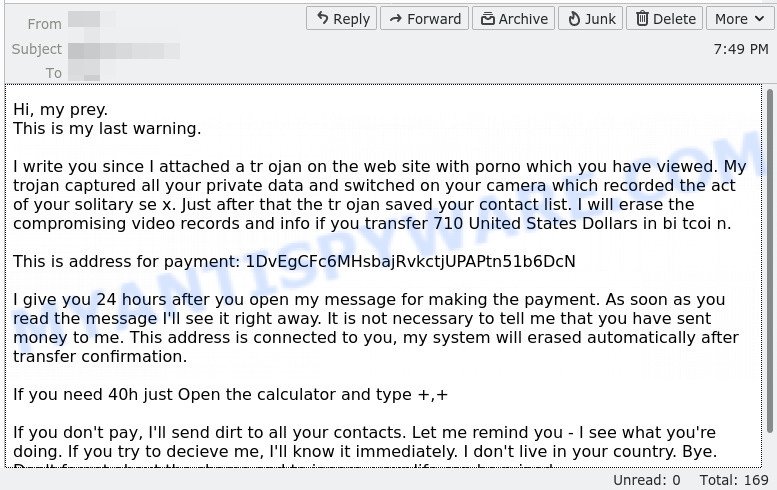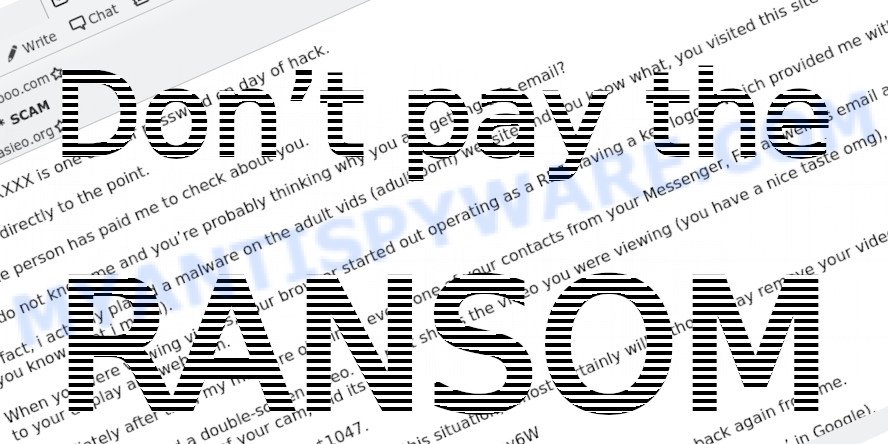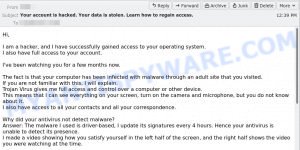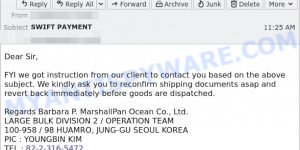Have you received a disturbing email with a text like “Hi, my prey. This is my last warning.“? This email is a prime example of an extortion scam known as “sextortion”, where cybercriminals attempt to intimidate and manipulate recipients into sending them money.
In this article, we’ll delve into the details of this scam, how it works, and most importantly, what you should do if you receive such an email.
Here’s an example of the “My prey, This is my last warning” email:

Table of Contents
Is this a scam email?
YES. The “My prey, This is my last warning” email is a classic example of a sextortion scam. Scammers use fear and intimidation to manipulate the recipient. The email claims that the sender has installed a trojan on a website you visited, capturing compromising content involving you and your contacts. To prevent the release of this supposed compromising material, the scammer demands a payment of 710 United States Dollars in Bitcoin within 24 hours.
Red-Flags Indicating It’s a Scam:
- Use of Fear and Intimidation: The email employs fear and intimidation tactics, such as claiming to have compromising material and threatening to expose it. Scammers use emotions to manipulate their targets.
- No Means of Verification: The scammer doesn’t provide a way for you to verify their claims, such as viewing the alleged compromising material.
- Generic Details: The email is very generic. This is a mass email sent to many people in hopes that a small percentage will get scared and pay.
- Urgent Timeline: The email imposes a strict and urgent timeline, often giving you just 24 hours to make the payment. Scammers want to pressure you into making a hasty decision.
- Demand for Payment in Cryptocurrency: The scammer demands payment in cryptocurrency, usually Bitcoin. This is a common tactic used by scammers as cryptocurrency transactions are difficult to trace.
In summary, 🚫 If you encounter such emails, it’s crucial to remain calm and not engage with the sender. Remember, these are empty threats designed to exploit your fears. It’s always best to protect your online presence and be wary of such tactics. 🛡️ Always ensure the safety of your devices, change passwords regularly, and be cautious about sharing personal information online.
How the scam works
Initially, you might wonder, “Where did they get my email address?” The answer lies in the numerous data breaches and online lists circulating on the dark web. Scammers can acquire vast lists of email addresses, sometimes coupled with other personal information, from various sources. They target these addresses in hopes that at least a few individuals will respond.
The ambiguous threats are their next weapon. 🚫 With a broad approach, they send out countless emails, betting on the chance that some recipients might be alarmed. They intentionally avoid mentioning any specific website or source of their alleged information, leading you to wonder, “Could there be any truth to this?”
Their narrative then deepens with a fictitious tale 🎭 of supposed system infiltration. They spin stories of having implanted malicious software on your device, insinuating they have access to your every move. Yet, conspicuously, they offer no real evidence to substantiate their claims.
In the final step of their ploy, they demand a ransom. 💰 Emphasizing quick payment, often via hard-to-trace channels like Bitcoin, is key to their strategy. By imposing a stringent timeframe, they hope to pressure you into acting impulsively, driven by fear and uncertainty.
The email read as follows:
Hi, my prey.
This is my last warning.I write you since I attached a tr ojan on the web site with porno which you have viewed. My trojan captured all your private data and switched on your camera which recorded the act of your solitary se x. Just after that the tr ojan saved your contact list. I will erase the compromising video records and info if you transfer 710 United States Dollars in bi tcoi n.
This is address for payment: 1DvEgCFc6MHsbajRvkctjUPAPtn51b6DcN
I give you 24 hours after you open my message for making the payment. As soon as you read the message I’ll see it right away. It is not necessary to tell me that you have sent money to me. This address is connected to you, my system will erased automatically after transfer confirmation.
If you need 40h just Open the calculator and type +,+
If you don’t pay, I’ll send dirt to all your contacts. Let me remind you – I see what you’re doing. If you try to decieve me, I’ll know it immediately. I don’t live in your country. Bye. Don’t forget about the shame and to ignore, your life can be ruined.
All in all, this scam uses tricks to make you scared and rushed. If you receive an email like this, do not engage with the scammer and do not send any money. Instead, delete the email and report it to the relevant authorities. It is also important to ensure that your computer has up-to-date anti-virus software and that you use strong, unique passwords for all of your accounts to reduce the likelihood of falling victim to scams like this.
Examples of such scams
The “My prey, This is my last warning” email scam is just one of the many deceptive schemes that prey on individuals’ fears and exploit their privacy concerns. Unfortunately, this type of scam is not unique, and there are various similar scams circulating online.
By examining these examples, you can better recognize the warning signs and arm yurself with knowledge to avoid becoming victims of fraudulent schemes. Take a closer look at the following scams: I RECORDED YOU Email Scam, Your Private Information has been Stolen Email Scam, and I am a professional hacker EMAIL SCAM and let’s learn how to safeguard ourselves from their deceitful tactics. Remember, knowledge is power.
- Geek Squad Email Scam (May 2023)
- Your account is hacked. Your data is stolen. Email Scam
- Reconfirm Shipping Documents Scam email
- Cash Settlement Awarded Email Scam
- Financial Assistance Department Email Scam
Should you pay?
No, you should not pay the ransom demanded by the scammer. Remember that this is a scam and paying the ransom will only encourage the scammer to continue their criminal activities! Additionally, paying the ransom can make you a target for future scams. It is important to stay vigilant and protect your personal information from such scams by using strong and unique passwords, enabling two-factor authentication, and regularly updating your computer’s security software. If you receive such an email, it is best to report it to the authorities and your email provider.

What to Do if You Receive the Email
Receiving the “‘My prey, This is my last warning'” email can be deeply unsettling, but with the right steps, you can ensure safety and peace of mind.

Here’s a specific guide on handling this scam:
Begin by reminding yourself to stay calm. The email is crafted to elicit panic, pushing recipients into rash decisions. Recognize its true nature—a manipulative attempt to exploit fear.
Resist any impulses to pay. Even if you’re tempted to make the problem go away, understand that payment doesn’t guarantee safety. It merely emboldens the scammer, possibly marking you as an easy target for future deceptions.
Do not engage with the scammer. Replying or trying to open a dialogue can inadvertently give away more information, or signal that your email is active, making you a prime candidate for further scams.
Seeing a familiar password can be particularly jarring. If the scam email mentions a password you recognize, it’s essential to check its source. Use services like haveibeenpwned.com to see if your email or credentials have been compromised in any past data breaches.
Subsequent to that, update your passwords. Always choose strong, unique combinations and activate two-factor authentication on platforms that support it.
As a precaution, run a comprehensive security scan on your device. While the scam email’s claims about malware are usually baseless, this step ensures your system remains clean and threat-free.
Report the email to relevant authorities (e.g., FTC). Sharing details with your local law enforcement or cybercrime units can contribute to ongoing investigations and aid in the crackdown on such malicious activities.
Lastly, spread awareness. Inform friends, colleagues, and family about the scam, equipping them with the knowledge to recognize and sidestep such threats. Knowledge, shared and acted upon, diminishes the effectiveness of these scams, making the digital world a bit safer for everyone.
Threat Summary
| Name | ‘My prey, This is my last warning’ |
| Type | Phishing/Sextortion |
| Ransom amount | $710 USD (in Bitcoin equivalent) |
| Bitcoin Address | 1DvEgCFc6MHsbajRvkctjUPAPtn51b6DcN |
| Fake Claims | Compromised data, webcam access, malware/backdoor installed |
| Damage | Psychological distress, potential financial loss if ransom is paid |
| Distribution | Mass emailing, likely from a purchased or hacked email list |
| Tactics | Fear induction, urgency, deception |
| Variations | Different ransom amounts, varying email content, alternative cryptocurrencies for payment |
| Prevention Tips | Use strong, unique passwords; enable two-factor authentication; be skeptical of unsolicited emails; never pay ransoms |
| Reporting Info | Forward to the Anti-Phishing Working Group at reportphishing@apwg.org; Report the scam to relevant authorities (e.g., FTC); Share information about the scam with friends and family to raise awareness; Monitor online accounts for any suspicious activity |
Conclusion
The ‘My prey, This is my last warning’ email scam shows how cybercriminals try to scare people into giving them money. They do things like pretending to send emails from your own address and making big claims without any real proof. The best way to deal with these scams is to understand how they work. Always be careful online, don’t make quick decisions based on these emails, and focus on keeping your information safe. If something sounds too alarming or too good to be true, it’s a good idea to double-check and not rush into any action.





















